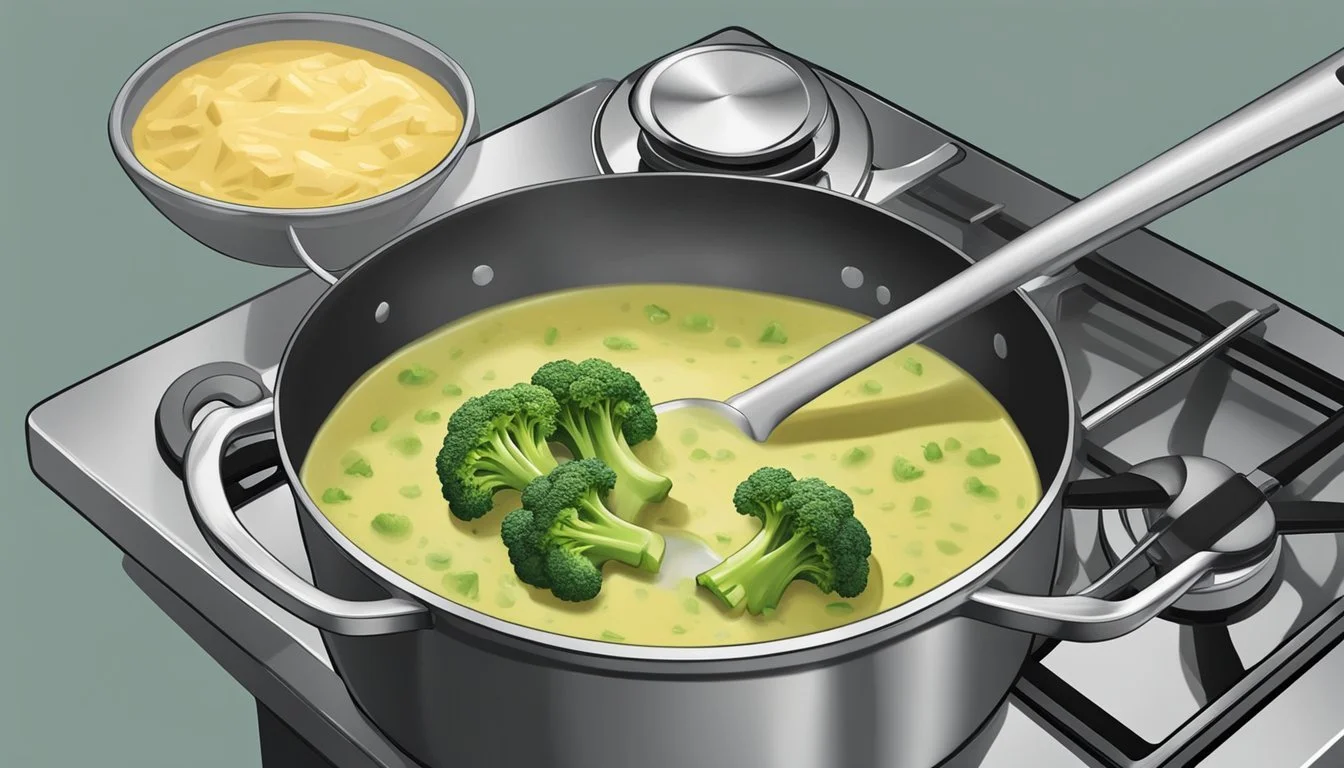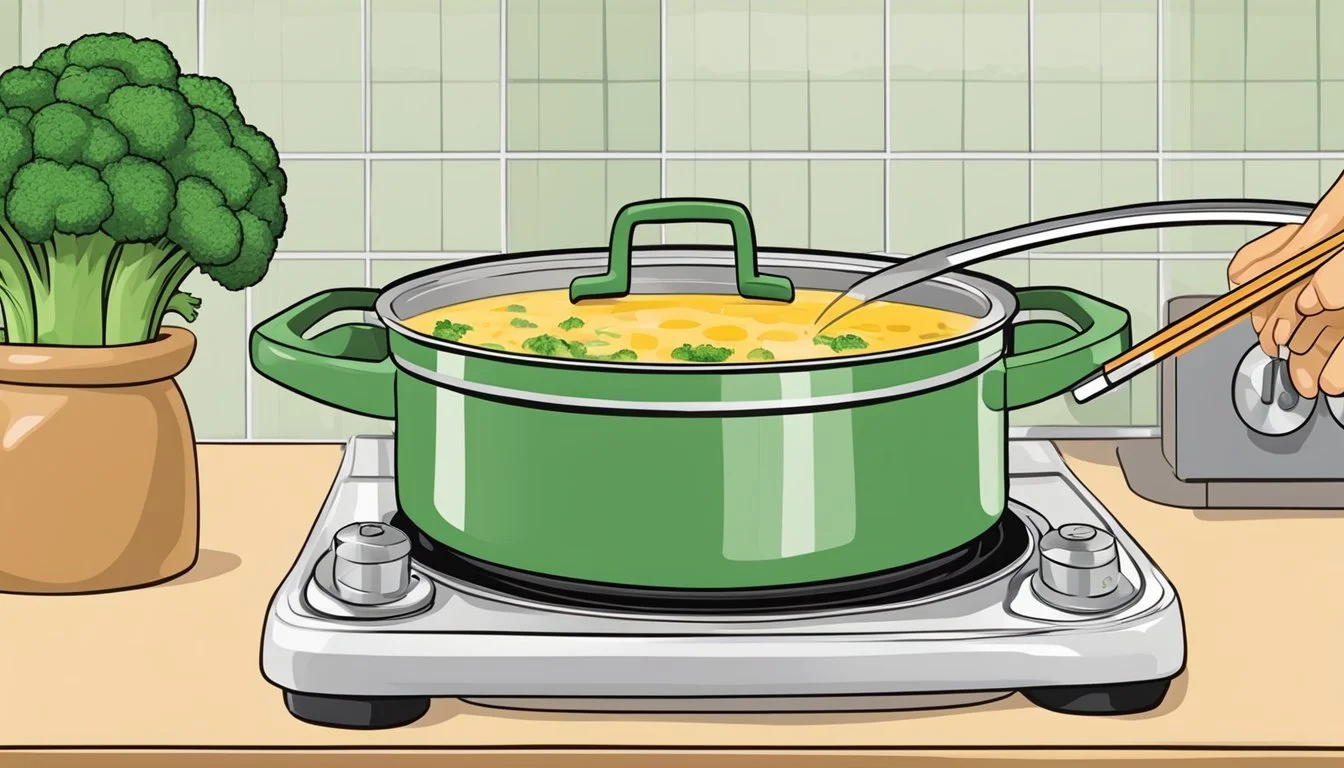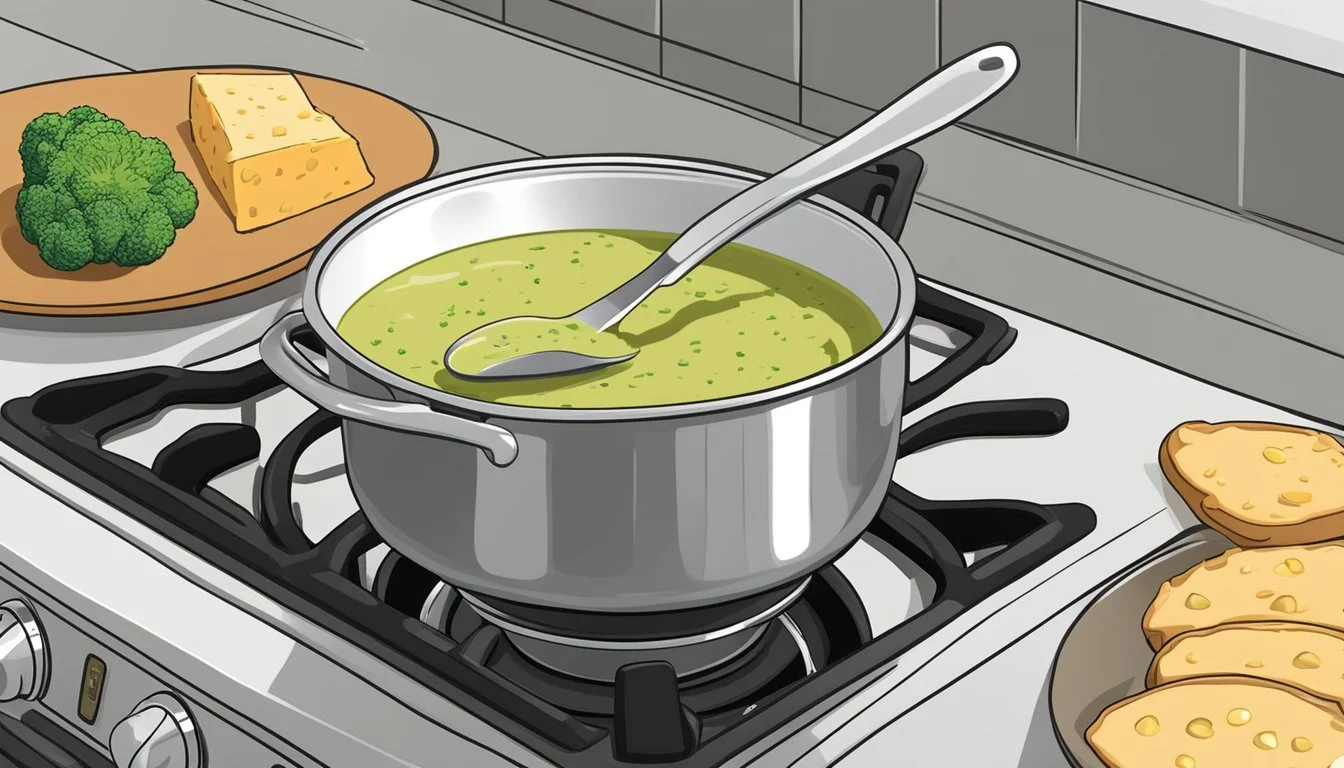Best Way to Reheat Broccoli Cheddar Soup
Tips for Creamy Warmth
Reheating broccoli cheddar soup while maintaining its creamy consistency is a simple yet essential process for enjoying this comfort food to its fullest. Broccoli cheddar soup, with its rich flavors and velvety texture, stands as a beloved dish that can be just as delightful the second time around when heated properly. The key to preserving the soup's appeal lies in the method of reheating, which directly affects the taste, texture, and overall quality.
Two main methods are most commonly recommended for reheating this type of soup: the stovetop and the microwave. Utilizing the stovetop allows for a gentle and controlled reheating process, which is critical to prevent the soup from separating or becoming grainy. On the other hand, the convenience of a microwave can appeal to those seeking a quicker method, though it requires care to uniformly warm the soup without overheating it. To ensure the soup's creaminess is preserved, stirring regularly and incorporating a small amount of additional liquid, such as milk or broth, can be integral steps in both methods.
Understanding Broccoli Cheddar Soup
Broccoli cheddar soup is a classic dish that relies on the harmonious blend of its key ingredients and the creaminess of the cheese to deliver its rich flavor. This section addresses the components and characteristics that define this beloved soup.
Key Ingredients
Broccoli: The star vegetable, it provides nutrients and a distinct, earthy flavor.
Cheddar Cheese: Preferably sharp cheddar for its intense flavor and smooth melting qualities.
Cream: Often heavy cream, contributing to the soup's thick texture.
Spices: Commonly salt, pepper, garlic, onion, and thyme to enhance taste.
The Importance of Creaminess
Achieving the right creaminess in broccoli cheddar soup is crucial, as it ensures a luxurious mouthfeel. The use of cream or half and half, along with the melting properties of cheddar cheese, impacts the soup’s viscosity and overall enjoyment.
Flavor Profile and Pairings
Flavor: Rich and cheesy with a comforting balance of spices. Broccoli's presence adds depth, while garlic and onion provide a savory note.
Pairings: Served with crusty bread for dipping, or paired with a light, crisp salad to contrast its richness. Parmesan may be added for an extra umami dimension.
Before Reheating
Ensuring a flavorful and safe consumption experience begins well before the reheating process. Proper storage of broccoli cheddar soup and knowing when to reheat are critical for preserving its taste and consistency.
Proper Storage Techniques
To maintain the quality and food safety of broccoli cheddar soup, it should be stored in an airtight container. If the soup will not be consumed within a few days, one can opt to freeze it, as this significantly slows bacterial growth and preserves the soup's texture. It is important to note that when stored at a temperature of 40°F or below, the soup remains safe for consumption and its creamy texture is retained.
Refrigerator Storage: Store in an airtight container for up to 3-4 days.
Freezer Storage: For long-term storage, keep the soup in a freezer-safe airtight container. Label with the date to track freshness.
If the broccoli cheddar soup is frozen, it should be thawed in the refrigerator overnight to ensure even temperature distribution during reheating. Avoid thawing at room temperature as it can lead to uneven texture changes and potential bacterial growth.
When to Reheat
Reheating should occur when the internal temperature of the broccoli cheddar soup drops below the recommended serving temperature, which is typically around 165°F for hot foods to ensure food safety. The ideal time to reheat the soup is within the following timeframes:
From Refrigeration: 3-4 days after initial storage to prevent any quality compromise.
After Thawing: Reheat the soup soon after it is fully thawed in the refrigerator to avoid quality degradation.
When the soup is ready to be reheated, it is imperative that one does so carefully to avoid overheating, which may affect the consistency and taste of the dish.
Choosing the Reheating Method
Reheating broccoli cheddar soup properly is essential to preserving its creamy texture and rich flavor. Whether one chooses the stovetop, microwave, or slow cooker, ensuring even heat distribution is crucial.
Stovetop Method
Using a saucepan is the preferred method for many when reheating broccoli cheddar soup. The individual should pour the soup into the saucepan and heat it on low to medium-low heat. It's imperative to stir frequently, as this not only preserves the creamy texture but also prevents the soup from scorching.
Microwave Method
When time is of the essence, the microwave provides a quick alternative. The soup should be placed in a microwave-safe bowl, loosely covered with a microwave-safe lid to allow steam to escape while preventing splatters. Heating should be done in one-minute intervals, stirring in between until the desired temperature is reached.
Slow Cooker Reheating
For gentle reheating, a slow cooker can be used. This method is ideal for keeping the soup at a serving temperature over a longer period. The soup should be placed in the cooker on low, and just like with the stovetop method, occasional stirring is recommended to maintain an even temperature and to keep the creamy consistency intact.
Mastering the Reheating Process
When reheating Broccoli Cheddar Soup, attention to detail can prevent curdling and preserve the soup's creamy texture. These methods aid in delivering a consistently delicious serving.
Preventing Separation and Curdling
To avoid separation and curdling, one must gently reheat the soup. Adding a splash of milk or broth can enhance creaminess and counteract any loss of moisture. Low-medium heat is crucial as too much heat can cause the dairy to separate. When reheating a soup thickened with flour or cornstarch, ensure it's heated through for safe consumption, but avoid boiling.
Ingredients prone to separation: dairy, cheese, thickening agents (flour, cornstarch)
Stirring Techniques
Stirring is essential to maintain the texture and prevent the ingredients from settling at the bottom. Use a spoon to stir the soup regularly and gently while reheating. This evenly distributes heat, merges the flavors, and ensures a smooth, creamy consistency.
Tools for stirring: wooden spoon, silicone spatula
Frequency: at regular intervals during reheating
Adjusting Temperature and Time
Utilize a food thermometer to heat the soup to an internal temperature of 165°F (74°C), safe for consumption. Reheating should be done over low to medium-low heat to prevent the creamy base from scorching. If using a microwave, heat in short intervals, stirring between each to distribute the warmth evenly.
Recommended temperature: 165°F (74°C)
Reheating environment: Low to medium-low heat
Method Temperature Time Stovetop Low-medium Varied until 165°F Microwave Medium (50% power) 1-minute intervals
How long broccoli cheddar soup lasts in the fridge: typically 3-4 days. Beyond this window, quality and safety can diminish. Ensure the soup has been stored properly before reheating.
Ingredients like shredded cheese, croutons, or fresh garnish should be added after reheating to maintain their texture and enhance the final presentation.
Enhancing the Reheated Soup
Once your broccoli cheddar soup is warmed through, enhancing its flavors and presentation can transform it from mere leftovers to a dish that feels freshly made. Focus on fresh ingredients and thoughtful garnishes to elevate the soup's taste and aesthetics.
Adding Fresh Ingredients
To boost the freshness and complexity of reheated broccoli cheddar soup, one can incorporate additional ingredients. Freshly steamed broccoli florets add texture and enhance the soup’s broccoli flavor. Sautéed garlic, carrots, celery, or leek also introduce a new depth of flavor. Here's a basic guide to incorporating fresh ingredients:
Broccoli Florets: Steam and add them once the soup is reheated.
Garlic: Sauté and stir into the soup to fortify its savory quality.
Vegetables: Dice carrots, celery, or leek; sauté until soft, then blend into the reheated soup.
Choosing Garnishes and Toppings
The right garnishes and toppings can not only improve the soup’s presentation but also its flavor profile. Consider the following options:
Cheese: Sprinkle freshly grated parmesan over the top for a nutty accent.
Bacon: Offer crumbled bacon for a salty, smoky crunch.
Cream: A drizzle of cream can create a rich and luxurious finish.
Fresh Herbs: Chopped herbs such as parsley or chives add color and a burst of freshness.
When serving, an emphasis on presentation with thoughtful garnishes ensures a visually appealing and delicious experience.
Serving Recommendations
To elevate the experience of enjoying broccoli cheddar soup, careful consideration should be given to the selection of sides, garnishes, and presentation techniques.
Sides and Accompaniments
Broccoli cheddar soup pairs excellently with a variety of sides. A classic choice is crusty bread, such as a baguette or sourdough, perfect for dipping and sopping up the creamy goodness. For a more substantial meal, one can serve it as a side to a main course like a crisp green salad or a hearty sandwich. Additionally, incorporating a kick of flavor with a dash of hot sauce or a sprinkle of paprika or mustard powder might entice those who appreciate a slight heat.
Side Options:
Baguette
Salad
Sandwich
Flavor Enhancers:
Hot sauce
Paprika
Mustard powder
Presentation Tips
The presentation of broccoli cheddar soup should not be overlooked. It should be served hot, to ensure the cheese is melted properly and to maximize flavor. A simple yet sophisticated approach can involve garnishing the soup with toppings such as shredded cheese, croutons, or a light sprinkle of herbs to add texture and visual appeal. One could also use a swirl of cream or a sprinkle of finely chopped herbs to create a visually striking contrast against the rich, orange soup.
Toppings:
Shredded cheese
Croutons
Chopped herbs
Garnishes for Contrast:
Cream swirl
Fresh herbs
Safety and Quality Assurance
Ensuring the safety and quality of reheated broccoli cheddar soup is crucial. Safe reheating practices mitigate bacterial growth, while maintaining the soup's creaminess and flavor. Correct internal temperature and proper covering are key practices.
Heating to the Correct Internal Temperature
For food safety, broccoli cheddar soup should reach an internal temperature of 165°F (74°C). This temperature is critical in hindering the growth of harmful bacteria. A food thermometer should be used to accurately measure the soup's internal temperature. To achieve uniform heat distribution, one should stir the soup occasionally during the reheating process.
Covering During Reheating
Covering broccoli cheddar soup while reheating serves dual purposes: it prevents moisture loss and protects against contamination. One can use a microwave-safe lid or plastic wrap when reheating in the microwave, ensuring the cover is loosely fitted to allow steam to escape. When reheating on the stove, a lid should be used to prevent splatters and retain heat efficiently.
Dealing With Leftovers
Proper storage and thawing are crucial for maintaining the texture and taste of broccoli cheddar soup leftovers. An understanding of how quality changes over time offers guidance on when to enjoy the leftovers.
Storing and Thawing
The key to preserving the creaminess of broccoli cheddar soup is to store it correctly. Leftovers should be placed in airtight containers to minimize exposure to air, which can cause texture changes and flavor loss. If the leftovers are not going to be consumed within a few days, freezing the soup is an option; however, it's important to note that dairy-based soups (What wine goes well with soups?) may separate when frozen and thawed.
To thaw, refrigerate the soup for several hours or overnight. Never thaw soup at room temperature as it can promote bacterial growth. For soups separated after thawing, gentle reheating while stirring can help recombine the ingredients.
Determining Quality Over Time
The quality of broccoli cheddar soup leftovers can diminish over time. The signs of degradation are changes in texture, such as becoming grainy or separating. If any unwanted odors develop, or if there is any visible mold growth, the leftovers should be discarded. Covering the soup with plastic wrap, pressing it directly onto the surface before storing, can help prevent such changes by reducing air contact even in airtight containers.
Nutritional Information
When considering how to reheat broccoli cheddar soup, it is also important to consider its nutritional profile. This creamy comfort food can be both nutritious and vegetarian-friendly, offering a range of benefits from its key ingredients.
Calories and Macronutrients
Calories: A standard serving of broccoli cheddar soup contains approximately 200-300 calories, but this can vary based on ingredients and serving size.
Macronutrients: The soup typically includes a balance of macronutrients, with protein from the cheddar cheese, carbohydrates from the vegetables, and fats primarily from the cheese and any cream used.
Nutrient Amount per serving Calories 200-300 Protein 10-15g Carbohydrates 20-30g Fats 10-20g
Health Benefits of Ingredients
Broccoli: Rich in vitamins C and K, fiber, and contains anti-inflammatory properties.
Carrots: A good source of beta-carotene, fiber, vitamin K1, potassium, and antioxidants.
Cheese: Provides calcium, protein, and vitamin B12.
While broccoli cheddar soup is often considered comfort food, its ingredients can boost nutritional intake, especially when it includes a variety of veggies. Its protein content can be particularly useful for vegetarians looking for satisfying, protein-rich meals. Additionally, its versatility allows for inclusion of various vegetables to enhance its nutrient density.
Alternative Methods and Tips
When reheating broccoli cheddar soup, it's crucial to maintain its delightful creaminess. This section offers guidance on adjusting the reheating process for dietary restrictions and suggests creative ways to revitalize leftover soup.
Making Adjustments for Dietary Restrictions
For vegan or lactose-intolerant individuals, dairy components in broccoli cheddar soup can be substituted with plant-based alternatives. These alternatives include soy, almond, or oat milk, which can affect the consistency of the soup; therefore, they should be incorporated gradually. During preparation, one must be careful to add these substitutes in small increments to prevent the soup from becoming too thin.
Vegetarian: Use vegetable broth instead of chicken broth.
Lactose-free: Opt for lactose-free cheese and milk.
Vegan: Replace cheese and milk with nutritional yeast and a plant-based milk alternative, respectively.
When reheating, ensure the soup's temperature is not too high to prevent curdling of alternative milk products.
Creative Uses for Leftover Soup
Leftover broccoli cheddar soup need not be limited to a reheated dish. It can be transformed into the base of a new recipe to ensure variety in one's meal planning. Here are a few suggestions:
Thickeners for Casseroles: Incorporate cooled soup as a creamy layer.
Sauce for Vegetables or Pasta: Gently reheat and pour over your favorite dishes.
One can also explore using the soup as a flavorful addition to other recipes that call for a cheese component, such as a cheese sauce for homemade macaroni and cheese. It is suggested to use a low heating method to preserve the flavor and avoid overheating, as that can alter the soup's desired consistency.








